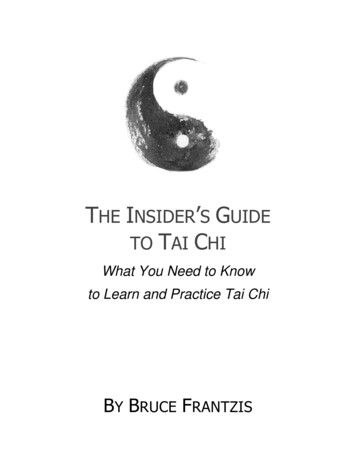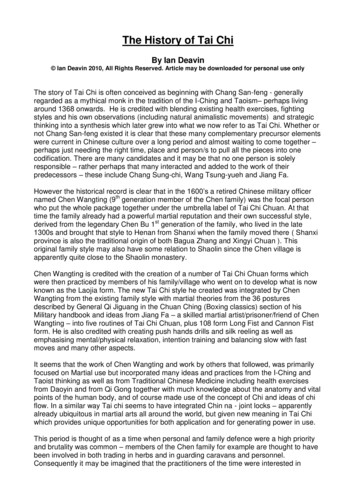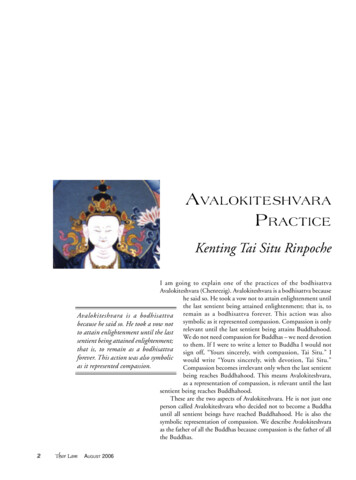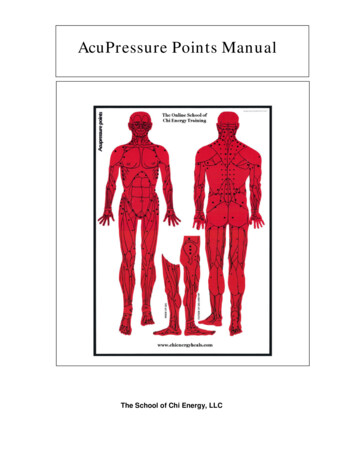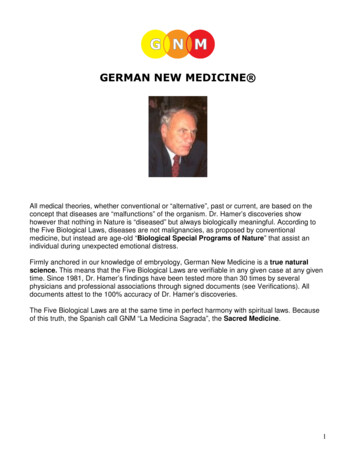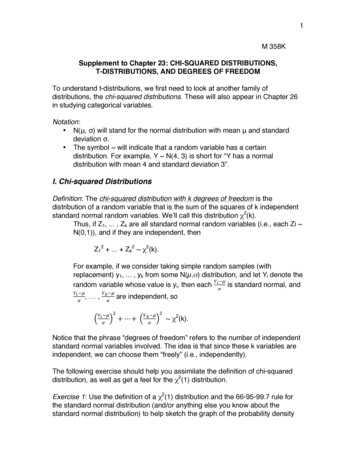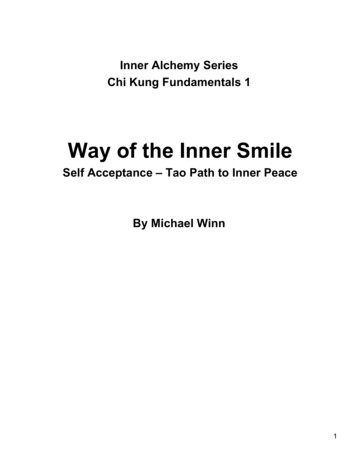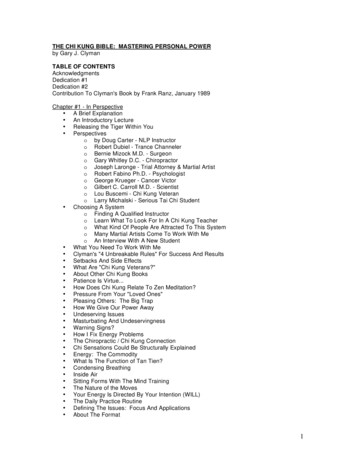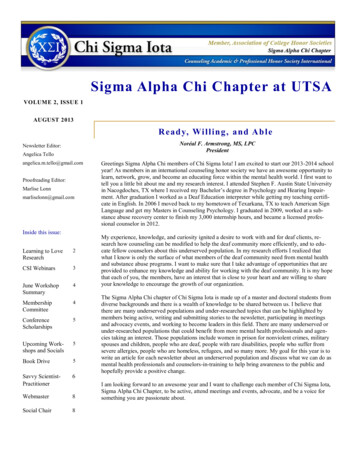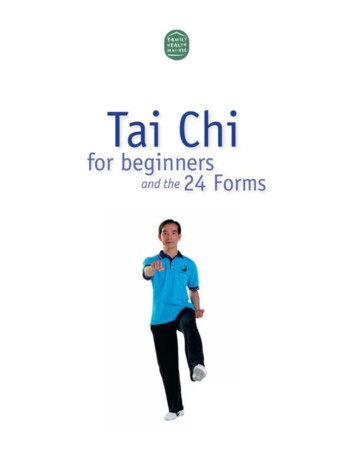
Transcription
ContentsForewordHow to use this bookPART 1For the beginnerCHAPTER 1What can tai chi do for you?CHAPTER 2Getting readyCHAPTER 3The Six Easy StepsCHAPTER 4What’s next?
PART 2The 24 FormsCHAPTER 5What you want to know about tai chiCHAPTER 6The 24, 48, 42 and other sets of formsCHAPTER 7Learning the 24 FormsPART 3Beyond the 24 FormsCHAPTER 8How to improve your tai chi
PART ght Page
ForewordOne could call us “The Odd Couple”. He’s Australian–Chinese; she’s American. He lives in Sydney;she lives in California. He’s a number (maths) person; she’s a word (language) person. What made usget together to write a book? Our common dedication to tai chi and our determination to share thelove of the art with others.We could say that this book and its contents were all our idea. In a way, that’s true. But it’s thenumerous tai chi beginners and enthusiasts we’ve talked to who have shown us the way. They’vehelped us decide what this book should be and what should be included. For example, they wanted abook that was easy and enjoyable to read. They wanted it to teach them authentic tai chi throughsimple instructions that work. Rather than learn tai chi as a martial art, they preferred to focus on thehealth benefits. Lastly, they wanted a reference book.We’ve tried to offer beginners all of the above and more. In Tai Chi for Beginners and the 24 Forms,we’ve made a conscientious effort to help the reader build a solid foundation right from the start, aswell as giving him or her a taste of higher level tai chi. And perhaps most important, we’ve done ourbest to make tai chi fun to learn.Our main goal with this book is to get you, the reader, “hooked” on tai chi so that the art will becomepart of your life. We couldn’t wish you anything more beneficial, fulfilling—or enjoyable.Dr Paul Lam and Nancy Kaye
How to use this bookFirst and foremost, you should know that we have organized this book by layers, just the way you, asbeginners, would progress. We have given you three steps or stages: beginning, intermediate andideas for progress. And that’s the way we all learn best, in progressive steps. You’ll find, forexample, that in Chapter 4, we add to your understanding of things you learned in Chapter 3.From experience, we’ve learned that teaching step by step enables beginners to gain thenecessary knowledge and skill in the easiest and most effective way.If knowing the background of tai chi is very important to you, you can read through all thechapters first (especially Part 2). But if you lean more towards “doing” rather than reading, you cansimply read the introductions to Chapters 1 and 2 and then go straight into the exercises in Chapter 3.Later on, you can go back to more in-depth reading.As a tai chi beginner and beyond, you can use this book by itself or in conjunction with classesand/or the instructional DVDs Tai Chi for Beginners and The 24 Forms. If you don’t have aninstructor, please be sure to make adjustments according to your own ability and requirements, andfollow the instructions carefully. In Chapter 3, there’s a suggested lesson plan with detailedinstructions for each step.For tai chi instructorsThe book is useful as a reference for advanced practitioners as well as tai chi instructors. Instructorscan use Dr Lam’s Six Easy Steps for classes without applying for permission to do so. However, beaware that it is your responsibility to teach safely. We provide a guide to safe practice in Chapter 2.
CHAPTER 1WHAT CAN TAI CHI DO FOR YOU?Tai chi, although a martial art, is practised primarily for its health benefits. And for good reasons.Scientific studies show that it helps chronic conditions such as arthritis, heart disease and diabetes,and that it also improves balance, prevents falls and reduces stress.The practice of tai chi includes cultivating qi, the vital life energy, which, in turn, relaxes us anduplifts our spirits. Most importantly, tai chi is an enjoyable form of exercise that people of any agecan learn and practise.
In a nutshell, tai chi can keep you healthy and happy. It’s remarkably effective for relaxation, healthand fitness. Besides that, it’s fun.Studies have shown that tai chi works magic on health, improving conditions such as arthritis,heart disease, diabetes, respiratory diseases and other chronic illnesses. In addition, it improvesbalance, prevents falls, aids good posture, and helps build immunity to disease. And if that’s notenough, tai chi also counters mental illness, depression and stress.Almost anyone can learn tai chi. Learning is inexpensive; tai chi can be practised almostanywhere. For the most part, the movements are slow and gentle, and you can easily adjust the degreeof exertion to suit yourself. So Just what is tai chi?Originating in ancient China, tai chi is an effective exercise for health of mind and body. Although anart with great depth of knowledge and skill, it can be easy to learn and soon delivers its healthbenefits. For many, it continues as a lifetime journey.There are many styles and forms of tai chi, the major ones being Chen, Yang, Wu, another Wu(actually two different words in Chinese) and Sun. Each style has its own unique features, althoughmost styles share similar essential principles. These include the mind being integrated with the body;fluidity of movement; control of breathing; and mental concentration. The central focus is to enablethe qi, or life force, to flow smoothly and powerfully throughout the body. Total harmony of the innerand outer self comes from the integration of mind and body, achieved through the ongoing practice oftai chi.
Here’s to your healthMedical and fitness authorities stress that effective exercise for health should include threecomponents: cardiovascular fitness, muscular strength and flexibility.Cardiovascular fitnessCardiovascular fitness means better heart–lung capacity. A good supply of blood and oxygen isessential for maintaining your health and for healing any disease.In 1996, a study was carried out involving 126 post-heart-attack patients. They were randomlyassigned to participate in either a tai chi class or an aerobic exercise class or a non-exercise supportgroup. The patients from the tai chi group came out with better cardiovascular fitness and lowerblood pressure than patients from the non-exercise group. Furthermore, 80 per cent of the people inthe tai chi group continued the practice of tai chi while the non-exercise support group retained only10 per cent of its original membership. The aerobic group retained fewer of its members than the taichi group and their diastolic blood pressure did not improve.
THE YIN, THE YANG AND THE QITai chi is based on traditional Chinese medicine, qigong (the method of cultivation of qi) andmartial art. Traditional Chinese medicine is based on a holistic understanding of humans as partof the universe and their constant interaction with the elements in the universe.The ancient Chinese believed that all things in nature were composed of yin and yang.While yin and yang are two polar opposites, they’re entirely complementary. Yin is viewed assofter, more pliant, yielding, feminine and sometimes negative, while yang appears moremasculine, harder, more rigid and more positive. In nature, everything moves towards a naturalstate of harmony and so yin and yang are always in total balance. Complementing each other, yinand yang form a perfect whole.Traditional Chinese medicine emphasizes that humans should exist in natural balance withnature in a spiritual and physical sense. When we are well balanced within ourselves and inbalance with nature, then we will have strong qi and be healthy.While some of these concepts may sound a little esoteric, the concepts of yin and yang andof tai chi have been validated. Over recent years, many studies have proven tai chi’s significanteffect in improving many aspects of health.The ancient Chinese regarded qi as the most important energy within the body. Qi in natureis the energy in the universe, and qi within the body is the driving power that maintains healthand spirit. Everyone is born with qi, and it diminishes with age or disease. The most importantfeature of tai chi is that it is designed to enhance the qi effectively. And the stronger your qi, thehealthier you are.StrengtheningBy strengthening our muscles, we keep our joints stable and protected. Of course, we need ourmuscles to move and when we move, the muscles pump fluid and blood throughout the body,improving the functions not only of the organs and joints but also the entire body.Many well-known sports heroes suffer from osteoarthritis resulting from injuries. Yet, they areable to perform at their peak level because their strong muscles protect their joints and reduce thepain of osteoarthritis. After they retire from active sports, however, and their training lapses, theirmuscles weaken. Arthritis flares up. Perhaps we can conclude that had they taken up tai chi uponretirement they would have stayed in shape and enjoyed a healthier, happier retirement.FlexibilityFlexibility improves our range of motion, making us more functional. Being flexible keeps our joints,muscles—our entire body—healthy, and allows us to be more active. Jim, a 56-year-old retiredfireman, is a good example of how tai chi can improve flexibility. As a result of an on-the-job injury,Jim couldn’t lift his arms any higher than his shoulders. Otherwise healthy, he experienced ongoingfrustration. He couldn’t reach up to cupboards; he couldn’t paint his house; he couldn’t even reach abook on a shelf above his head. Jim had given up hope of ever returning to normal. Then, simply toget exercise, he took up tai chi. Within six months, normal flexibility had returned to his shoulder
joints. He could reach up. His life changed.Let’s get it straightIn addition to these three main components of healthy exercise, tai chi also improves posture, animportant component of health. Developing correct posture will result in less wear and tear of thejoint muscles. When your posture is upright, the lung space is larger. Try taking a deep breath andexpanding your chest. You’ll notice that there’s more space in the chest. Now try to hunch. The spacein your chest diminishes, doesn’t it? As you can see, the body works better in an upright posture.Shirley suffered from lower back pain and sciatica problems for some time before she starteddoing tai chi. Tai chi really helped her. “I think part of the reason I got better was that tai chistrengthened my back muscles and made me conscious of keeping good posture throughout the day,”she says. “I don’t slouch any more. It has really made a difference.”Good posture in turn promotes better balance, thus preventing falls and the resulting injuries.Shirley goes on to say, “Tai chi has also strengthened my ankles. I was twisting and spraining themonce or twice a year. Now, between my stronger ankles and better posture, I enjoy better balance, andas I get older, I’ll be less likely to fall.”
FALLS PREVENTIONTwo recent studies have confirmed the effectiveness of tai chi in reducing the likelihood of fallsin older adults. The first was published by Journal of Advanced Nursing in 2005*. Says coauthor Professor Rhayun Song (who is also a master trainer of the Tai Chi for Arthritisprogram): “As people get older they are more likely to experience falls and this can lead tosome very serious health issues Our study shows that low-intensity exercise such as tai chihas great potential for health promotion as it can help older people to avoid falls by developingtheir balance, muscle strength and confidence.”A group of 68 older adults was divided into a tai chi group and a control group. Afterfollowing the Tai Chi for Arthritis program designed by Dr Lam and based on Sun style, the taichi group reported improved muscle strength and less risk of falls than the control group. It wasconcluded that the tai chi program can improve physical strength and reduce fall risk in fallprone older adults in residential care facilities.The second study, conducted by Sydney Central Area Health Promotion Unit between 2001and 2004 involved approximately 700 people and was the largest fall prevention study in theworld. After 16 weeks of doing a tai chi program (80 per cent of the participants did the Tai Chifor Arthritis program), the results showed that “tai chi significantly reduced the number of fallsby almost 35 per cent. Tai chi also significantly reduced the risk of multiple falls byapproximately 70 per cent.” The study concludes: “Compared with other falls preventioninterventions, the trial showed that tai chi is one of the most effective ways of preventing falls inolder people”. *** Choi, J.H., Moon, J.S., and Song, R., “The Effects of Sun-style tai chi exercise on physical fitness and fall prevention in fallprone adults”, Journal of Advanced Nursing, 2005.** Sydney South West Area Health Service, Falls Prevention Newsletter, Spring 2005.It’s all in your headThe mind is the most important aspect of health. It’s a universally accepted fact that the mind controlsthe body. Surely you’ve heard of people overcoming disabilities thanks to their positive attitude andstrong mind. And tai chi, as one of the most powerful mind–body exercises, teaches the student to beaware of the intrinsic energy from which he or she can derive greater self-control and empowerment.Almost everyone who practises tai chi recognizes its powerful effect on relaxation andconcentration. Take Joanne, for example. About 10 years ago while driving, she was injured in a caraccident. She suffered seven pinched nerves between her skull and her coccyx. Her frequent businesstravel didn’t help. For years she lived in pain.Finally, a chiropractor suggested she try tai chi. “A six-week introductory course was enough toget me hooked,” says Joanne. “I found that, even in that short time, what we were doing was enoug
Tai chi is based on traditional Chinese medicine, qigong (the method of cultivation of qi) and martial art. Traditional Chinese medicine is based on a holistic understanding of humans as part of the universe and their constant interaction with the elements in the universe. The ancient Chinese believed that all things in nature were composed of yin and yang. While yin and yang are two polar .
